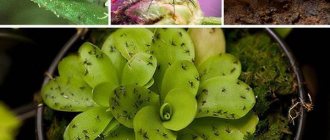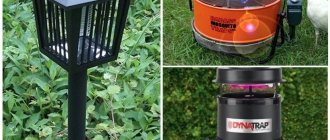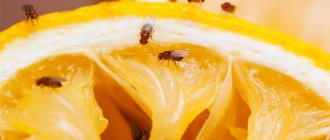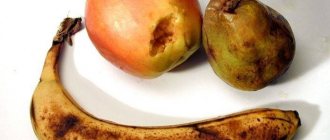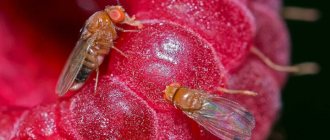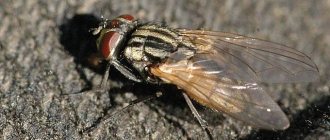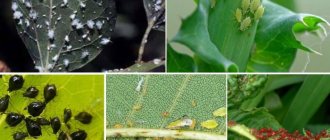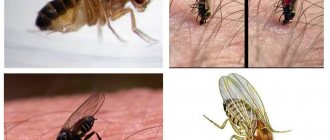What types of midges are there?
First, let's figure out what kind of pests these are. And in order to make it easier for you to identify the insects that attacked your favorite flower, we suggest conditionally classifying them according to a very simple and striking feature - color. Most often, black or white midges are found on indoor plants.
White midges on flowers - whiteflies, scale insects
White midges include whiteflies and scale insects . They can be found on the leaves and stems of plants, on the soil surface. They often run around the pallet. Adult insects look like moths. The most dangerous time is the first quarter of the year, winter and spring. It is at this time that white midges are most active.
The main danger comes from the larvae of whiteflies and scale insects. They are usually located on the inside of leaf blades, but can also be found at the roots. The larvae feed on plant sap. Signs of their appearance are colorless spots on the leaves.
The whitefly is especially dangerous. This pest multiplies at a fantastic rate and can destroy all your plants incredibly quickly.
Black midges in flowers - sciarids
Black midges living in home flowers are called sciarids , and another name for these parasites is fungus gnats . They prefer to live near the root system of flowers such as aloe, Decembrist, ficus, azalea. For humans, this type of insect creates considerable inconvenience in the apartment - it gets into food or drink. Settling in the soil where the flower grows, they make it dense and impervious to air, thus causing enormous damage to the roots of the plants.
Black midges on house flowers are called sciarids or fungus gnats
Flying midges in indoor flowers
It also happens that flower pots become habitats for fruit flies or fruit flies. This is the most harmless type of midge that does not harm either plants or people, causing the latter only psychological discomfort. If fruit flies are infested in an indoor flower, it is necessary to deprive them of all possible sources of food (rotting vegetables, fruits, tea leaves, coffee, etc.), and then destroy all adult individuals using traps or a regular vacuum cleaner.
Soil midge in indoor flowers
Ground flies in indoor flowers are called springtails or springtails. Their body length ranges from 0.2 to 1 mm, and any energizer would envy their activity - most of the day they busily jump from leaf to leaf, scurry along the surface of the soil, populating it with their larvae. If you look closely on the surface of the soil in a pot, you will notice clusters of these small insects.
Adult healthy plants are not afraid of soil midges in indoor flowers. They even play an important role, participating in the process of decomposition of organic matter and saturating the soil with oxygen. Pord larvae living in flower pots, carrying pathogenic fungi and eating up rotten roots, are dangerous only for flooded or diseased flowers.
Aphid
Aphids can also be included in the group of midges, although the colony of pests consists of winged female dispersers, wingless insects and larvae. Aphids are small in size (1-5 mm) and have an oval soft body.
Houseplants are more often affected by greenhouse aphids. She multiplies quickly. It sucks cell sap from the leaves, which leads to their deformation and contamination with sweet secretions.
Signs of plant damage
It is not difficult to notice affected plants. It is enough to touch the leaf and small midges will begin to fly away. It is better not to wait until the pest has gone through its full development path. The larva is difficult to notice, so it is recommended to pay attention to the leaves. Their surface has small spots with a white coating.
Whiteflies most often live on plants such as:
- peppers;
- tomatoes;
- cucumbers;
- zucchini.
Important: scientists have identified about 1,600 species of whiteflies, so they can also be found on other plants.
Most often, the pest appears in greenhouses, but it can be found on the leaves of vegetables in open ground. Despite its small size, the insect reproduces quickly. Therefore, it is necessary to get rid of it as soon as possible.
Reasons for the appearance of midges in flowers
Let's figure out why this problem arises - the appearance of midges in flowers
. There are several reasons why midges appear on plants; you should know them in order to properly care for your flowers.
First reason
– the soil was initially contaminated with midge larvae. Next time, remember that before planting plants in the soil, it must be disinfected.
In addition, the soil should be periodically treated against pests for prevention. This will prevent the appearance of parasitic colonies in the soil.
The second reason
– excessive waterlogging of the soil, especially in winter. This happens due to abundant and frequent watering - the water in the pot stagnates and contributes to the appearance of unwanted insects.
Third reason
– a constantly open window through which midges fly in and settle in the damp soil.
Fourth reason
– fallen leaves of plants that begin to rot in the pot, creating favorable conditions for the appearance of pests.
If you regularly carry out preventive disinfection of the soil and follow all the conditions for caring for plants, you will never have the question of how to get rid of midges from flowers in a pot.
We choose proven means to get rid of flies in a flower pot
Even an attentive and experienced gardener can get flies on indoor plants in flower pots. How to get rid of uninvited insects without waiting for them to spread to all plants, and what measures to take to prevent re-infection - these issues should be resolved quickly and competently. And then the home flower garden will again delight with strong, healthy shoots.
Inspecting indoor plants and pots
So, let's start inspecting your flowers and soil. The very first sign of these insects is, of course, flying flies around potted plants. Less obvious symptoms include:
- white grubs in the ground;
- sudden wilting of the plant;
- poor growth of young plants;
- yellowing of leaves or massive loss of leaves.
If your flower has midges, what should you do? The first rule is don't panic. The chances of saving your favorite orchid or violet are great. But the fight for salvation must begin immediately.
How to get rid of midges in flowers: 5 important steps
So, you've noticed little midges flying around your indoor plants at home. What's next? Here are five easy steps to get rid of midges in your flower pots.
Step 1: Find and eliminate the source of excess moisture!
As we said above, these are usually plants growing in overwatered soil - in pots, a flower bed or a greenhouse. But midges can also live in overly mulched soil, which retains moisture for a long time after rain.
They are not very active fliers, so they usually live near water. Found the source? If it is rotting organic waste, dispose of it; in the case of soil, shake it up - you should see white larvae.
Step 2: Don't water the soil!
You can simply leave the infested pot without watering for a while - in dry soil, midge eggs will not be able to turn into larvae, existing larvae will die, and they will no longer be able to reproduce...
But this is a very expensive price to pay: with a serious infection, during these days the parasites can finally finish off the poor flower. And if a whole area is flooded, the wait will take even longer! In such cases, do not hesitate - use Bti (see next point).
Step 3: Treat the soil - get rid of midge larvae with Bti
Larvae are much more dangerous than adult midges - so the main step is to get rid of the larvae, and not the adults.
To treat soil or other moist breeding ground, it is not necessary to look for special insecticides; you can get by with already proven organic mosquito control agents.
Entomologists recommend using Bti to eliminate larvae - special live bacteria that kill insect larvae before they have time to become adults.
This affordable (~$20) and safe product has proven itself to be a successful product for killing mosquito larvae, and judging by happy reviews, it is also effective against midges and fungus gnats.
To treat soil in a pot, first lower the “donut” into a watering can so that the product dissolves in water, and then pour the resulting solution onto the soil. If the infection occurs in an outdoor area, break it into pieces and sprinkle it on waterlogged soil or also dissolve it in water and spill it.
Following the instructions, repeat the procedure as necessary (until new larvae stop appearing) - usually the problem is solved within 2-3 weeks.
Step 4: Kill midges in flower pots with sticky traps
At the same time as eliminating moisture and fighting larvae, we kill adult females so that they do not lay new eggs. Sticky traps are great for this and can then be left in the ground for ongoing monitoring.
They are not much different from each other: an adhesive base, a bright yellow color and the same principle: midges stick and die, bypassing the stage of laying eggs. You can use the following products (or similar):
For a small infestation: Safer Brand 5025 Houseplant Sticky Stakes Insect Trap (7 traps) (~$6)
For large infestations: Hafer 30-Pack (15ea.5″*3″yellow Dual sticky trap and 15pcs wire tie) set (~$7)
Step 5: Create a schedule for watering your plants
When you have finally gotten rid of fungus gnats, the most important thing is to draw conclusions from the situation and prevent it from reoccurring, i.e. do not overwater the soil! Make a watering schedule and take into account important nuances:
- different plants require different frequency of watering and light levels;
- choose the right pots for indoor plants - the choice largely depends on the type of root system;
- in winter, all plants consume less moisture, so make watering more moderate (it’s not for nothing that these insects are called winter midges!);
- Conduct preventive inspections of your potted and outdoor plants for parasites.
Chemical repellents
If folk remedies have not helped get rid of flies in a flower pot, you cannot do without the achievements of modern chemistry. Heavily contaminated soil must be replaced completely, freeing the roots from it. Then the entire plant along with the roots is treated with one of the special insecticides. “Fitoverm”, “Aktellik”, “Bazudin”, “Aktara” are suitable for exterminating pests.
To prevent re-infestation, you should only use soil that has been steamed or spilled with insecticide and follow the watering regime, avoiding excessive moisture in the soil in the pot.
Ways to combat flower flies - video
Midges on flowers: how to get rid of them using mechanical methods
How to remove midges from flowers? Try to get rid of the adults first. To do this use:
- vacuum cleaner;
- electric mosquito fumigator.
The latter must be connected to an outlet located as close as possible to the flowers. To be sure, leave it running for at least a week.
After hatching adult insects, you will still have to get rid of the larvae. Young whiteflies can be easily collected from leaves with a sponge soaked in a solution based on laundry soap. Take the last 30 g per liter of warm water.
Midges in flowers? What to do if they are covered with soil? There is no alternative to a transplant. The roots of the plant should be washed thoroughly. Take store-bought soil and, if you have the slightest doubt about its quality, sterilize it in the oven (100 °C, calculate the time as follows - 30 minutes for each liter of soil).
Chemical preparations for midges
Chemical preparations for midges
Chemical preparations for midges are much more effective than folk remedies. They destroy adults and larvae and save plants from invasions. However, they also have a drawback. Such drugs can be dangerous for pets, birds, people, and they can also be toxic to indoor flowers. So you need to use them with caution!
- It is better to use insecticides for plants on the balcony, veranda, and in the yard. It is better not to use them indoors. In addition, before diluting the liquid and spraying flowers, it is important to study the instructions!
How to fight midges with folk remedies
Many gardeners have encountered pests on plants, but not everyone knows how to get rid of midges in indoor flowers. But there are many folk remedies that are highly effective at home. So, how to get rid of midges in indoor flowers using improvised means:
Get a carnivorous plant
Looking for something a little more exotic like pest control? Pick up a carnivorous plant and let it eat! This is an unusual, but quite acceptable method for getting rid of midges.
Cold quarantine
Plants that can tolerate a temperature drop of up to 10 °C (for example, fuchsias and geraniums) should be left on the balcony for a week in the cool season. This will help get rid of the adults.
Pharmaceutical preparations against flies (ammonia, potassium permanganate, etc.)
Ammonia. Ammonia is a universal remedy that improves the growth of indoor plants and helps remove parasites. Experienced gardeners regularly use ammonia to water their plots. Water the flowers with a solution of ammonia, diluting 25 ml of alcohol in 2 liters of water.
Potassium permanganate. When watering, replace ordinary water with a weak solution of light pink potassium permanganate. As a rule, a couple of waterings are enough.
Balm “Star”. Insects cannot tolerate its pungent odor. If you lubricate the edges of the pots with “Star”, this will help cure flowers from midges at home.
Boric acid. Prepare the solution yourself by dissolving 1 g of powder in a liter of water, and then water the plants with it.
Citramon. 2 tablets are ground into powder and dissolved in 1 liter of water.
Acetylsalicylic acid and caffeine have a detrimental effect on midges.
Methods for controlling whiteflies
Getting rid of whiteflies in a greenhouse on cucumbers and tomatoes in a short time is problematic. But if you systematically and consistently use a set of pest control methods, you can reduce their number significantly.
Prophylactic
To prevent the appearance of the pest in the greenhouse, the following preventive work is carried out:
- install ventilation equipment;
- paint metal structures indoors;
- Every autumn, all hard-to-reach places are disinfected with solutions of copper sulfate (200 g per 10 l of water) or potassium permanganate (2-4 g per 10 l of water);
- in the intervals between harvesting and planting seedlings, fumigate the premises using sulfur or tobacco bombs (due to a violation of the acid-base balance of the soil, new plants can begin to be planted 2 weeks after treatment);
- carefully check the seedlings; when planting in a permanent place, observe the recommended distances (30-50 cm) between plants;
- with the onset of cold weather, the soil freezes;
- remove last year's tops and compost heaps, do not place them near greenhouses and beds.
People's
This method of removing pests is traditionally practiced by gardeners. Labor-intensive but environmentally friendly, it includes the use of various traps, baits and herbal infusions.
Here are a few recipes for the products used for processing:
- Garlic tincture – has bactericidal properties and repels pests, suitable for watering and spraying tomato and cucumber seedlings. It is prepared as follows - 100-150 g of chopped garlic are infused in 10 liters of water for 24 hours.
- Infusion of yarrow (100 g per 1 liter of water, infused for 1 day) or dandelion roots (80 g per 1 liter of water, infused for 1 day) - spray on plants affected by whitefly.
- Soap solution - laundry or tar soap is rubbed on a fine grater and diluted in warm water in a ratio of 1:6, the infected leaves of vegetable crops are treated and then washed off with running water.
How to avoid midges, prevention
It is necessary to properly care for our pets.
The purchased flower must be transplanted into new soil, treated and disinfected with special means. To do this, you can use purchased soils, and if you prepare the soil yourself, it must be calcined in the oven at a temperature of 100 degrees.
Adjust proper watering habits
Pests such as fruit flies and black midges in flowers thrive in moist soil; eggs and larvae cannot survive without a constant moist environment. Chances are your plant can handle less water than you give it. Try testing the soil with your finger and watering only when it is completely dry, at least 2-3 cm. If you are not very good at measuring the moisture yourself, you can take a moisture sensor and place it directly in the soil. Remember that overwatering is the number 1 reason for the death of indoor flowers!
Consider Drainage and Humidity
The level of soil moisture depends on whether the pot with soil has special drainage. Not all plants and flowers are suitable for highly moist soil. The filler for a pot for indoor flowers requires 15% air, 35% moisture and 50% soil. And here you can’t do without drainage, which creates comfortable conditions for the greenhouse. Too much moisture displaces 15% of the oxygen needed by plants. Drainage is necessary because this is the only way unnecessary liquid can escape and the roots of the plant can breathe. If using a tray under the flowerpot, empty the tray immediately after watering to prevent moisture buildup.
Pruning as a means of controlling midges
Trim dying or dead foliage from the plant daily, especially in areas close to the soil line, and remove spilled plant material from the surface as soon as you notice it. The less organic material decomposes, the less midges there will be in the pot!
How midges get into flower pots
These midges can appear in a pot in different ways:
- end up in purchased or garden soil that is poorly disinfected;
- fly through an open window in the summer and lay eggs in the damp soil of a flower pot;
- get together with vegetables or fruits and multiply, and then migrate to flowers.
Excessive soil moisture promotes the fastest reproduction of midges in flower pots. In warm and humid conditions, larvae quickly hatch from laid eggs and begin to actively feed. Soon this becomes noticeable by the unhealthy appearance of the indoor plant - it withers, the leaves wither and fall off, despite abundant watering.
In the initial stage, plant infection is difficult to determine. You should carefully examine it - the top layer of soil and the underside of the leaves.
If insects are noticed on the leaves, and small white larvae are found in the ground, urgent measures need to be taken before the pests spread everywhere.
Video - Midges in indoor flowers. How to get rid of midges?
Which method of controlling midges you use is up to you to decide, based on your own experience and preferences.
Sources
- https://7dach.ru/technoexport/kak-izbavitsya-ot-moshek-v-cvetah_2-244613.html
- https://moyasotka.com/tsvety/komnatnye/moshki-v-komnatnyh-tsvetah-kak-izbavitsya-ot-nezvanyh-gostej.html
- https://TaraKlop.ru/moshki/moshki-v-komnatnyh-cvetah-kak-izbavitsya/
- https://womanadvice.ru/moshki-v-komnatnyh-cvetah-samye-effektivnye-metody-borby
- https://kursi-floristiki.ru/komnatnye-cvety/moshki-v-komnatnyh-cvetah.html
- https://ogorodlegko.ru/zashhita-rastenij/217-moshki-v-komnatnyh-cvetah.html
- https://antinasekom.ru/kak-izbavitsya-ot-moshek-v-tsvetah.html
- https://stoppestinfo.com/ru/434-kak-izbavitsya-ot-moshek-v-tsvetakh.html
- https://www.nur.kz/1849521-kak-izbavitsa-ot-mosek-v-cvetah.html
- https://fermerok.info/kak-izbavitsya-ot-moshek-v-komnatnyh-tsvetah
- https://GdeKlop.ru/moshki/izbavitsya-v-komnatnyh-cvetah/
- https://agronomva.ru/moshki-v-komnatnyh-czvetah/
- https://hozhelp.ru/uborka-doma/sposoby-borby-s-cvetochnymi-i-fruktovymi-chernymi-moshkami.html
- https://Lifehacker.ru/moshki-v-komnatnyx-cvetax/
- https://VrediteliSOS.ru/nasekomye/moshki-v-cvetah-komnatnyh-kak-izbavitsya.html
- https://odomah.org/1498362012992539040/zavelis-tsvetochnye-moshki-v-kvartire—kak-borotsya/


